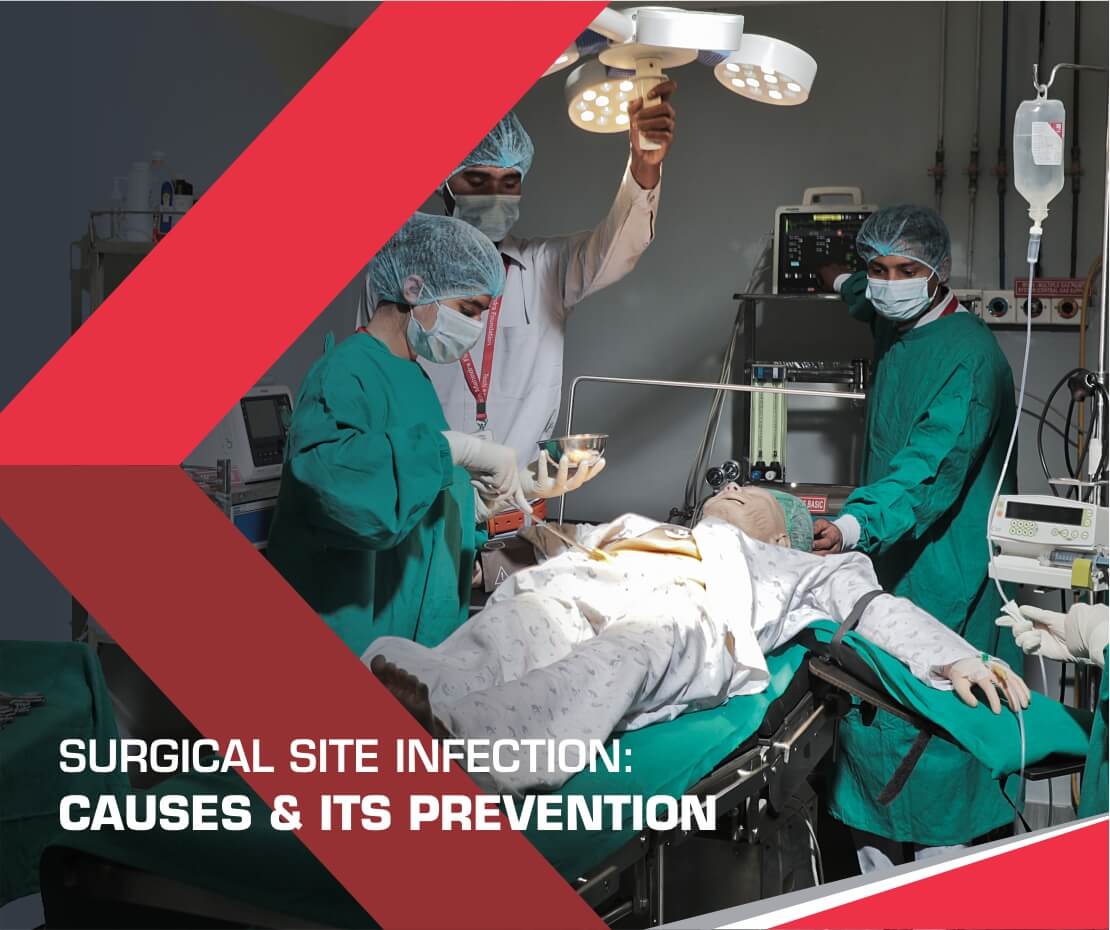Table of Contents
ToggleAn infection that occurs in the part of a body after surgery is known as Surgical Site Infection (SSI). The incidence of SSI is monitored by the National Nosocomial Infections Surveillance (NNIS) system of the Centers for Disease Control and Prevention (CDC). In India, according to NNIS data, SSIs are the third most frequently reported nosocomial infection and are associated with substantial morbidity that endangers a patient’s life. Let us understand in details about surgical site infection, the causes and the preventive measures.

Types of Surgical Site Infections
An SSI typically occurs within 30 days after surgery. According to the CDC, there are three types of surgical site infections:
- Superficial Incisional SSI: It will happen in the area of the skin where the incision was done
- Deep Incisional SSI: This infection will occur under the incision area in the muscle or tissues around muscles
- Organ or Space SSI: Such infections will occur in any part of the body except for the skin, muscle or surrounding tissues involved in the surgery. It includes a body organ or a space between organs.
Sources of Surgical Site Infections
There are two sources of Surgical Site Infections, which are:
- Exogenous or External Sources: This type of sources includes personnel, environment, improper sterilization in the operation theatre, materials used for surgery and negligence of staff after the surgery
- Endogenous or Internal Sources: Here, the SSI occurs due to the patient’s own flora, which means through the microorganisms present on patients own skin
Causative Organisms
In most cases, after surgery, the infections are caused by organisms. The most common organisms that causes infection are Staphylococcus, Streptococcus, and Pseudomonas.
Signs and Symptoms of Surgical Site Infections
The most common symptoms of surgical site infections are redness in the patient’s body, delayed healing, fever, pain, tenderness, warmth, or swelling. Also, there are other signs and symptoms for specific types of SSI, such as:
- A superficial incisional SSI may produce pus from the wound site. Samples of the pus may be grown in a culture to find the types of organism that are causing the infection.
- A deep incisional SSI may also produce pus. In this case, there is a chance that the wound site may reopen on its own or a surgeon may reopen the wound and find pus inside the wound.
- An organ or space SSI may show a discharge of pus coming from a drain placed through the skin into a body space or organ. A collection of pus, called an abscess, is an enclosed area of pus and disintegrating tissue surrounded by inflammation.
Classification of Surgical Wounds
The degree of risk for an SSI is linked to the type of surgical wound. The various surgical wounds are:
- Clean Wounds: These wounds are not inflamed or contaminated. Also, they do not involve operating on an internal organ.
- Clean-contaminated Wounds: Such wounds have no evidence of infection at the time of surgery. These surgeries involve operating on an internal organ.
- Contaminated Wounds: These type of wound involve operating on an internal organ while spilling contents from the organ into the wound.
- Dirty Wounds: These are the wounds in which a known infection is present at the time of surgery.
The Risk Factors for Surgical Site Infections
The various factors that risks of having an SSI are:
- Surgery that lasts more than 2 hours
- Having other medical problems or diseases
- An elderly adult
- Overweight
- Smoking
- Having cancer
- Weak immune system
- Diabetes
- Emergency surgery
- Abdominal surgery
- Wound contamination is a significant risk factor for developing SSI
- Procedural variables include factors related to preoperative skin preparation, sterilization protocols, and the surgery itself
Key Principles for Preventing Surgical Site Infection
There are two important measures that can be taken to avoid SSIs, which are Preoperative and Perioperative. The preoperative measures are:
- Tobacco cessation at least 30 days prior to the elective surgery
- Antimicrobial prophylaxis i.e. use the correct agent for the type of operation. Administer 30 to 60 minutes before incision, re-administer if surgery is delayed beyond 1 hour after the first dose & maintain at therapeutic levels throughout surgery.
- Preoperative showering with chlorhexidine gluconate 4% solution the night before surgery and in the morning before surgery.
- No removal of hair or, if the removal is necessary then clipping the hair immediately before the surgery
The Perioperative measures are:
- Prevent intraoperative hypothermia
- Monitor and control glucose levels at HbA 1c < 7%
- Consider supplemental oxygen to prevent perioperative hypoxia
Hospitals’ Responsibility to Prevent Surgical Site Infections
Few important and necessary steps to help prevent surgical site infections:
-
- Washing of Hands: Before the operation, surgeons and all operating room staff must scrub their hands and arms with an antiseptic soap
- Clean Skin: The site where an incision is to be made must be carefully cleaned with an antiseptic solution
- Sterile Clothing and Drapes: Members of the surgical team should wear long-sleeved surgical gowns, masks, caps, shoe covers, and sterile gloves. The patient’s body should be fully covered with a large sterile sheet (sterile drape) except for the spot where the incision is to be made
- Clean Air: The operating rooms must have special air filters and positive air pressure to prevent unfiltered air from entering the room
- Careful use of Antibiotics: Antibiotics are to be given not more than 60 minutes before the incision is made and generally stopped within 24 hours after surgery
- Controlled Blood Sugar Level: The patient’s blood sugar level may rise because of the stress of the surgery. Therefore, the blood sugar level must be watched closely to make sure it stays within a normal range. Rise in the blood sugar delays the healing of the wound and increases the chances for infection.
- Controlled Body Temperature: A lower-than-normal temperature during or after surgery prevents oxygen from reaching the wound and makes it harder for the body to fight infection. Hospitals may warm IV fluids, increase the temperature in the operating room, and provide warm-air blankets.
- Proper Hair Removal: Any hair that must be removed is clipped right before the incision, not shaved with a razor. This prevents tiny nicks and cuts through which germs can enter.
- Wound Care: After the surgery, a closed wound must be covered with a sterile dressing for a day or two. Open wounds must be packed with sterile gauze and covered with a sterile dressing.
SSI Preventive Training at Tech Mahindra SMART Academy for Healthcare
At हेल्थकेयर के लिए टेक महिंद्रा स्मार्ट अकादमी, students from the batches of ऑपरेशन थियेटर टेकनीशियन (OTT) and General Duty Assistant (GDA) course are trained to deal with SSIs. It is important for these students at the Academy to have knowledge about the Surgical Site Infections, the consequences and the preventive measures.
SSI preventive training for OTT batch students is important because they are responsible for the setting up of the operation theatre and other pre and post-surgery procedures. While the students from the जनरल ड्यूटी असिस्टेंट batch go through the SSI training as they directly deal with the patients before and after the surgery.
Surgical site infections are a major threat to patients. They can range from minor skin infections to severe or fatal ones involving tissues under the skin or organs. Healthcare professionals need to implement best-practice recommendations for SSI prevention. Effective surgical infection prevention requires redesigning systems to reduce risk factors and to optimize evidence-based processes of care.

